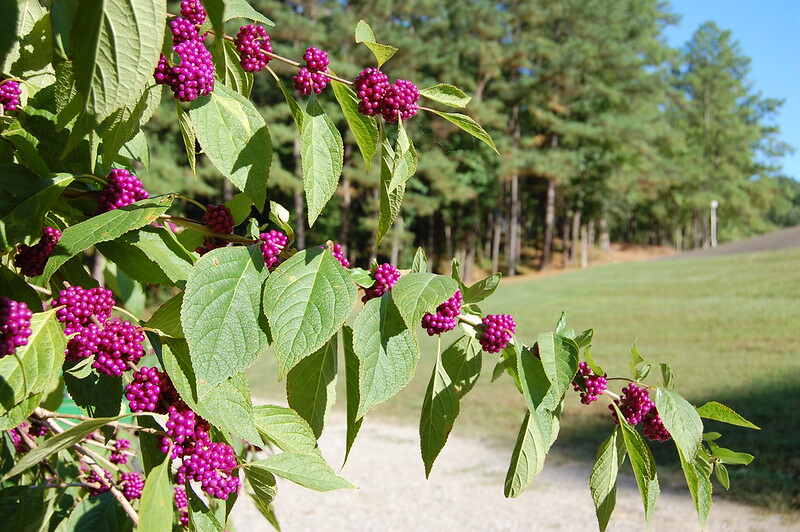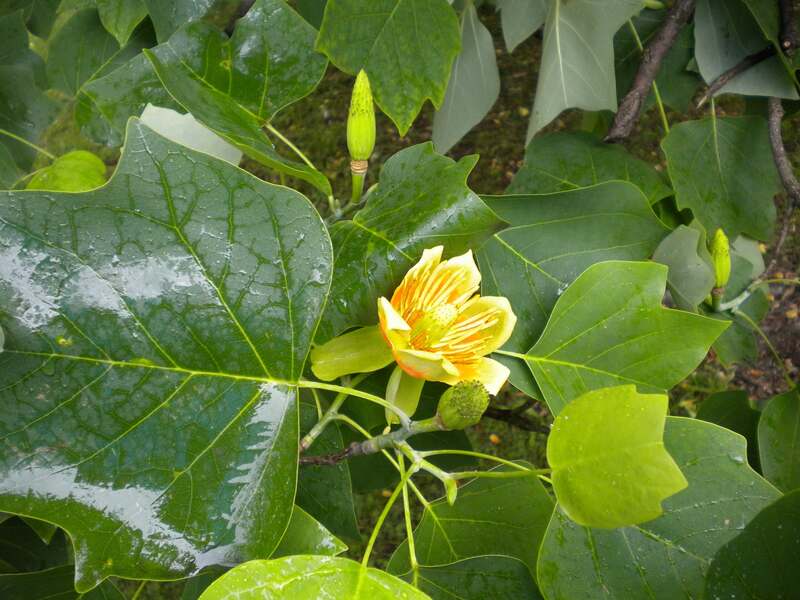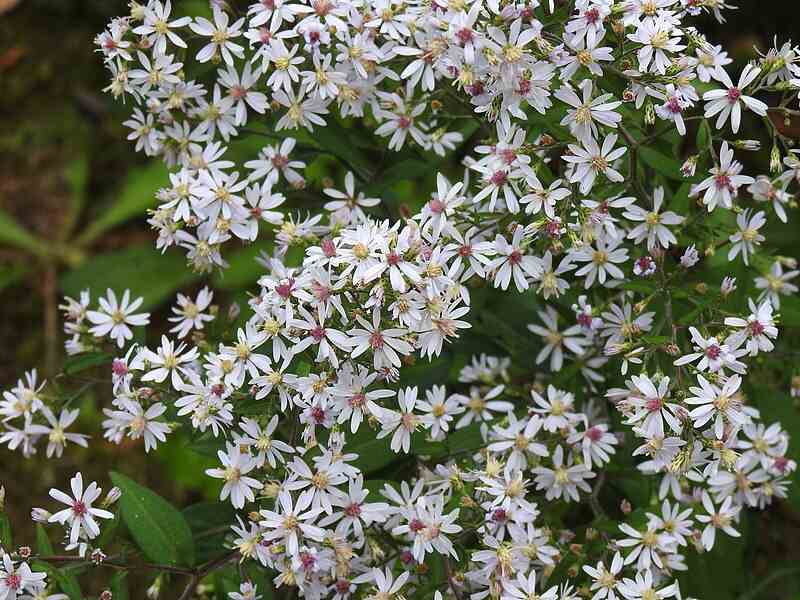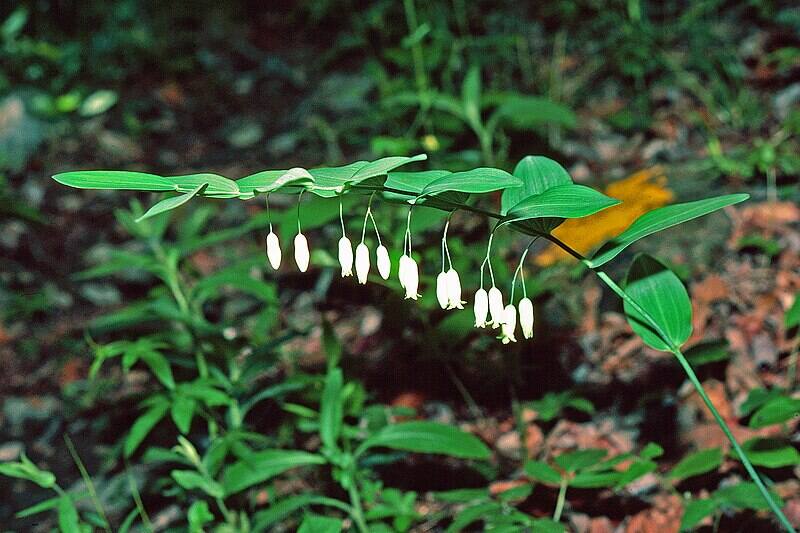
Your home lawn can also encompass the hidden treasures of Tennessee’s natural landscapes. Native plants are perfectly suited to the state’s unique climate and soil conditions, offering an enchanting and sustainable option for your backyard. To make the process easier, we bring you a selection of the 24 best Tennessee native plants to embellish your home.
What are Native Plants?

Native plants are species that have adapted over time to occur naturally in a certain region, contributing to the local ecosystem. For homeowners who want a vibrant, colorful landscape with fewer maintenance requirements, going native offers the best of both worlds.
Native Shrubs for Tennessee
American Beautyberry (Callicarpa americana)

Native to the eastern part of Tennessee and sparsely present in the western portion of the state, this deciduous shrub produces stunning violet or magenta berries that attract birds and other mammals that feed on them.
- Plant type: Shrub
- USDA Hardiness zones: 7-11
- Sun: Full sun to partial shade
- Soil: Prefers moist clay or amended sandy soil
- Foliage: Deciduous
- Bloom time: June to September, producing berries in October
- Water needs: Low (1 inch per week)
- Mature size: 3 to 6 feet tall and the same width
- Potential hazards: None
Common Buttonbush (Cephalanthus occidentalis)

With fragrant white flowers, buttonbush spreads its perfume statewide. It is commonly found in swamps, pond banks, and wetlands. Songbirds eat the small nutlets this shrub produces. You can help save the bees by planting a buttonbush. It will draw bees and showy butterflies to your garden.
- Plant type: Shrub
- USDA Hardiness zones: 5-9
- Sun: Full sun
- Soil: Grows in various soil textures as long as it’s wet to moderately wet
- Foliage: Deciduous
- Bloom time: July to August
- Water needs: Average to high
- Mature size: 5 to 12 feet high by 5 to 12 feet wide
- Potential hazards: Leaves are poisonous to cattle
Red Chokeberry (Aronia arbutifolia)

A great choice for landscaping, red chokeberry blooms in spring with clusters of delicate white flowers. The berries are not attractive to wildlife, but the leaves’ outstanding red color during fall certainly is appealing to homeowners who want a beautiful winter garden.
If you have drainage problems, these water-loving shrubs can help improve drainage in your yard by soaking up some of the extra water.
- Plant type: Shrub
- USDA Hardiness zones: 3-9
- Sun: Full sun, partial shade
- Soil: Prefers rich soils but can grow in fine to coarse soil textures
- Foliage: Deciduous
- Bloom time: Spring
- Water needs: Average
- Mature size: 6 to 11 feet high and 3 to 5 feet wide
- Potential hazards: Although edible, the fruits are potently astringent and can cause choking.
Cayenne Silky Dogwood (Cornus amomum ‘Cayenne’)

This deciduous shrub fits perfectly as a hedge or as a single plant if you plan to build a rain garden. Silky dogwood produces small white flowers and blue fruits that will certainly attract birds. In autumn, the leaves turn vibrant orange, and beautiful red stems are revealed once they fall. And you can use pruned stems as part of your Christmas decorations!
- Plant type: Shrub
- USDA Hardiness zones: 4-9
- Sun: Full sun to partial shade
- Soil: Prefers acidic, well-drained, moderately wet soils. Will need supplemental watering in periods of drought.
- Foliage: Deciduous
- Bloom time: May to June
- Water needs: Moderate (medium moisture levels)
- Mature size: 6 to 8 feet tall and 8 to 10 feet wide
- Potential hazards: None
Oakleaf Hydrangea (Hydrangea quercifolia)

Native to the Highland Rim and Coastal Plain areas, oakleaf hydrangea has large leaves with bold texture, and its flowers bloom in showy white panicles. You can plant it en masse or use it in a shrub border. Since it grows on old wood, it is a good idea to prune right after flowering.
- Plant type: Shrub
- USDA Hardiness zones: 5-9
- Sun: Full sun to part shade
- Soil: Prefers rich soils but can grow in sandy loams and moderately fine silt loam
- Foliage: Deciduous
- Bloom time: Summer
- Water needs: Low (1 inch per week)
- Mature size: 6 to 8 feet tall and 6 to 8 feet wide
- Potential hazards: Oakleaf hydrangea is mildly poisonous. It can cause nausea, stomach pain, and vomiting if ingested.
Smooth Serviceberry (Amelanchier laevis)

This member of the rose family can grow as a shrub or as a tree, making it useful as a shade tree or in shrub borders and hedges. A flowering shrub, its showy white flowers will make your landscape pop when spring comes.
- Plant type: Shrub
- USDA Hardiness zones: 4-8
- Sun: Full sun and partial shade
- Soil: Coarse to medium loams, acidic, moist to slightly dry soils
- Foliage: Deciduous
- Bloom time: Spring
- Water needs: Medium
- Mature size: 15 to 25 feet tall, with the same spread
- Potential hazards: None
Common Spicebush (Lindera benzoin)

Often found along stream banks in the central and eastern U.S., spicebush is an ornamental shrub that works well as a hedge or in your rain garden. With fragrant yellowish-green flowers, this plant hosts swallowtail butterflies. Its fruits also serve to attract birds to your yard.
- Plant type: Shrub
- USDA Hardiness zones: 5-9
- Sun: Full sun to partial shade
- Soil: Prefers moderately wet fertile loam. Spicebush can also grow in loamy sands and silt loams.
- Foliage: Deciduous
- Bloom time: March to April
- Water needs: Medium
- Mature size: 6 to 12 feet tall and 6 to 12 feet wide
- Potential hazards: None
Shrubby St. John’s-Wort (Hypericum prolificum)

Native to Middle and East Tennessee, the shrubby St. John’s-wort is a hardy, highly adaptable shrub. It tolerates drought and erosion. The puffy yellow flowers are an important source of pollen for bees, so it’s a great native plant for your pollinator garden.
- Plant type: Shrub
- USDA Hardiness zones: 3-8
- Sun: Full sun to part shade
- Soil: Grows in moderately wet to dry soil and tolerates a wide variety of textures, including sandy and rocky soils
- Foliage: Deciduous
- Bloom time: Summer
- Water needs: Moderate
- Mature size: 1 to 5 feet tall and 1 to 4 feet wide
- Potential hazards: Poisonous if ingested, causing gastrointestinal symptoms. Also causes contact dermatitis.
Native Trees for Tennessee
Red Buckeye (Aesculus pavia)

Common to east Tennessee, the bright red flowers of the red buckeye are a delight to the eye. They are also a tasty snack for migrating butterflies and attract hummingbirds that feed on their nectar. Red buckeye is often used for landscaping, screening, or in rain gardens.
- Plant type: Tree
- USDA Hardiness zones: 4-8
- Sun: Full to partial sun
- Soil: Well-drained, moist, acidic soil
- Foliage: Deciduous
- Bloom time: Mid-April to May
- Water needs: Low to moderate
- Mature size: 15 to 20 feet tall and 12 to 15 feet wide
- Potential hazards: Seeds, leaves, and sprouts are severely toxic to both humans and animals when ingested.
Tulip Poplar (Liriodendron tulipifera)

The Tennessee state tree is also one of the largest native trees in the eastern U.S. forests. With shiny green leaves and tulip-like flowers, tulip poplar makes a great fast-growing shade tree and is a favorite nesting area for birds.
- Plant type: Tree
- USDA Hardiness zones: 4-9
- Sun: Full sun
- Soil: Acidic, moist, and well-drained soils
- Foliage: Deciduous
- Bloom time: Spring
- Water needs: Moderate
- Mature size: 60 to 90 feet tall with up to a 30 to 50 foot spread
- Potential hazards: They present low levels of toxins but are not considered toxic to humans or pets.
Eastern Redbud (Cercis canadensis)

Easy to grow, the eastern redbud has a rounded shape. This deciduous tree can adapt well to various soil types as long as it doesn’t get too wet, but you will need to provide extra water to take care of this tree during drought.
Perfect as understory trees, they also form a stunning scene when combined with evergreens that will contrast with and enhance their bright purplish-pink color.
- Plant type: Tree
- USDA Hardiness zones: 4-9
- Sun: Full sun or partial shade
- Soil: Any moist, well-draining, nutrient-rich soil
- Foliage: Deciduous
- Bloom time: March and April
- Water needs: Moderate
- Mature size: 20 – 30 feet tall, with 25 – 35 foot spread
- Potential hazards: Contains toxic saponin, but the substance is poorly absorbed by the body and might not cause any problems.
Fringe Tree (Chionanthus virginicus)

Beautiful all year round, the fringe tree’s bright yellow color enhances the landscape in the fall, and its bark’s red furrows adorn it in the winter. In spring, the tree blooms in fragrant, creamy-white petals resembling fringes, making it a good choice for a front yard showpiece tree. Additionally, the tree’s olive-shaped fruits feed local small mammals and birds.
- Plant type: Tree
- USDA Hardiness zones: 3-9
- Sun: Full sun, partial shade
- Soil: Prefers average to rich well-drained soil with neutral to alkaline pH. It also tolerates clay soils.
- Foliage: Deciduous
- Bloom time: April to May
- Water needs: Medium
- Mature size: 12 to 20 feet tall with the same width
- Potential hazards: None
Sugar Maple (Acer saccharum)

The sugar maple, renowned for its vibrant yellow and orange hues, is known for its stunning fall colors. It serves as an excellent choice for lawns with ample shade, as it tolerates shady environments better than other types of trees. Be aware that maple tree diseases can be an issue; however, many are treatable.
- Plant type: Tree
- USDA Hardiness Zone: 3-8
- Sun: Full sun, partial shade, full shade
- Soil: Rich, well-drained, moist soils
- Foliage: Deciduous
- Bloom time: April to May
- Water needs: Medium
- Mature size: 60 to 75 feet; can grow up to about 100 feet tall
- Potential hazards: Toxic to horses but nontoxic to dogs, cats, and humans
Kentucky Coffeetree (Gymnocladus dioicus)

Unfortunately, you can’t just put your mug below Kentucky coffeetree and get a free refill. But early American settlers roasted the brown seed pods to use as a substitute for coffee, giving the tree its name.
Nevertheless, the coffeetree’s seed pods create a beautiful visual against the winter sky, making a great landscaping element for large lawns. Keep in mind its mature size to pick the right site to plant your tree.
- Plant type: Tree
- USDA Hardiness Zone: 3 to 8
- Sun: Full sun
- Soil: Deep, rich, moist sandy loams or silty clays. Can adapt to a variety of soils as long as they are well-drained.
- Foliage: Deciduous
- Bloom time: Late spring and early summer
- Water needs: Medium
- Mature size: 60 to 80 feet tall and 40 to 55 feet wide
- Potential hazards: Leaves, seeds, and pulp of the tree are poisonous to livestock, humans, and pets.
Native Flowers for Tennessee
Common Blue Wood Aster (Symphyotrichum cordifolium)

The blue aster, a perennial herbaceous plant, can be found throughout the state but is particularly abundant in east Tennessee. Its striking blue flowers, hence the plant’s name, are highly attractive to butterflies. If you’re looking for low-maintenance options to add to your cottage or butterfly garden design, the blue wood aster is a perfect choice.
- Plant type: Herbaceous
- USDA Hardiness Zone: 3-8
- Sun: Full sun to partial shade
- Soil: Well-drained, moist soil. Adaptable to a variety of soil textures, except clay.
- Duration: Perennial
- Foliage: Deciduous
- Bloom time: Fall
- Water needs: Low to Medium
- Mature size: 2 to 5 feet tall and 1 to 2 feet wide
- Potential hazards: None
Bee Balm (Monarda bradburiana)

Mainly found in the western and southern regions of the Highland Rim, bee balm is an eye-catching herb for those who want an exuberant, yet easy-to-grow, plant. It attracts bees, hummingbirds, and butterflies, making it an ideal addition to a pollinator garden. When building a pollinator garden, be sure to include bee balm on your list.
- Plant type: Herbaceous
- USDA Hardiness Zone: 5-8
- Sun: Full sun, partial shade
- Soil: Tolerates poor soils, even clay and rocky soils. Prefers acidic pH and well-drained soils.
- Duration: Perennial
- Foliage: Deciduous
- Bloom time: Summer
- Water needs: Low to moderate
- Mature height: 1 to 2 feet tall with 1 to 2 foot spread
- Potential hazards: None
Wild Blue Phlox (Phlox divaricata)

The pale blue flowers of the wild blue phlox are guaranteed to embellish your lawn in any of the many uses this native wildflower can have: as a groundcover, in border fronts, or in a calming rock garden. Rabbits love to chew on phlox, so you might need to protect your plant from them. It also attracts pollinators such as bees and hummingbirds.
- Plant type: Herbaceous
- USDA Hardiness Zone: 3-8
- Sun: Partial shade, full shade
- Soil: Prefers moderately wet to dry rich organic soil with moderately acid to neutral pH. Prefers rocky or sandy soils, but can adapt to different soil types, including clay.
- Duration: Perennial
- Foliage: Semi-evergreen
- Bloom time: Spring and early summer
- Water needs: Medium
- Mature size: 12 to 18 inches tall and 10 inches to 1 foot wide
- Potential hazards: Non-toxic to humans or animals.
Virginia Bluebells (Mertensia virginica)

These low-maintenance yet stunning wildflowers are common in middle and east Tennessee. Virginia bluebells have beautifully bell-shaped flowers in shades of blue and pink that bring a touch of magic to your home each spring.
Combine them with begonias or other annuals to fill up the space they leave when they go into summer dormancy. Bluebells are also a good choice if you want to create a shade garden.
- Plant type: Herbaceous
- USDA Hardiness Zone: 3-8
- Sun: Part shade to full shade
- Soil: Prefers rich, moist but well-drained humus. Tolerates various soil types except for rocky soils and heavy clay. Likes a moderately acidic to slightly alkaline pH.
- Duration: Perennial
- Foliage: Deciduous
- Bloom time: Spring
- Water needs: Average. It does its best when moisture is abundant and will decline when the soil is too dry.
- Mature size: 12 to 18 inches in height and 1 to 1.5 feet in width
- Potential hazards: Although not considered toxic, it can cause dermatitis in some people and contains small amounts of alkaloids that can become toxic if consumed in large quantities.
Butterfly Milkweed (Asclepias tuberosa)

If you want a smaller and tidier species you can grow in your garden bed, the butterfly milkweed might be what you’re looking for. Milkweeds are an important part of the local ecosystem, as they are a host for monarch butterflies and an array of other pollinators, including beetles, bees, moths, and wasps.
- Plant type: Herbaceous
- USDA Hardiness Zone: 3-9
- Sun: Full sun
- Soil: It struggles in overly fertile soils and thrives in various poor soils, even heavy clay soils.
- Duration: Perennial
- Foliage: Deciduous
- Bloom time: Early June to August
- Water needs: Low to average
- Mature size: 1 to 2 feet tall and 1 to 1.5 feet wide
- Potential hazards: Milkweed is a plant that is poisonous to dogs, cats, and horses.
Black-Eyed Susan (Rudbeckia hirta)

This native wildflower is found sparsely in west Tennessee but more commonly in the prairies and meadows of Middle and east Tennessee. Displaying striking yellow flowers, black-eyed Susan can be used to add color to gardens or borders.
- Plant type: Herbaceous
- USDA Hardiness Zone: 3-7
- Sun: Full sun
- Soil: Prefers moderately wet, well-drained soils. Adapts to various soil types but can’t tolerate coarser, rocky soils. Likes slightly acidic to neutral pH.
- Duration: Can act as a biennial, annual, or short-lived perennial
- Foliage: Deciduous
- Bloom time: Summer
- Water needs: Medium. It has moderate drought tolerance.
- Mature size: 1 to 3 feet
Tennessee Purple Coneflower (Echinacea tennesseensis)

This rare wildflower is found near Nashville in the Central Basin’s cedar glades. This Tennessee treasure was once an endangered species, but has since recovered. They demand little care, making them perfect for drought-tolerant landscaping. The ray-like flowers are irresistible to American goldfinches, who will certainly pay your garden a visit.
- Plant type: Herbaceous
- USDA Hardiness Zone: 5-6
- Sun: Full to partial sun
- Soil: Grows in medium to dry moisture levels. Prefers acidic and sandy soils but can tolerate other soil types.
- Duration: Perennial
- Foliage: Evergreen
- Bloom time: Summer
- Water needs: Medium
- Mature size: 1 to 2 feet tall and 1 to 1.5 feet wide
- Potential hazards: None
Columbine (Aquilegia canadensis)

With leaves as charming as its flowers, columbine is found throughout east and Middle Tennessee. Blooming in spring with red flowers, this plant can self-seed in favorable conditions and is deer-resistant — great qualities if you’re searching for a low-maintenance option for groundcovers, wildflower gardens, and shady borders.
- Plant Type: Herbaceous
- USDA Hardiness zone: 3-8
- Sun: Full sun to full shade
- Soil: Clay, silt, or sandy soil that’s well-drained, moderately moist, or dry-ish. Columbine prefers neutral to slightly alkaline pH.
- Duration: Perennial
- Foliage: Deciduous
- Bloom time: Spring
- Water needs: Moderate. Requires waterings weekly or whenever the soil is completely dry.
- Mature size: 2 to 3 feet tall and 1 to 1.5 feet wide
- Potential hazards: Moderately flammable
Cardinal Flower (Lobelia cardinalis)

Growing statewide, the cardinal flower’s blossoms have a vibrant, exuberant red color and are loved by hummingbirds. This herbaceous perennial will need a constant water supply, especially if exposed to full sun. Due to its moisture-loving characteristics, it makes a perfect addition to water gardens, rain gardens, or as an ornament along ponds.
- Plant type: Herbaceous
- USDA Hardiness zone: 3-9
- Sun: Full sun to partial shade
- Soil: Prefers wet or medium wet soil, as long as it’s rich and with a slightly acidic pH. It doesn’t tolerate clay soils.
- Duration: Perennial
- Foliage: Deciduous
- Bloom time: Summer
- Water needs: Medium to high
- Mature size: 2 to 4 feet tall and 1 to 3 feet wide
- Potential hazards: Toxic if eaten in large quantities. Has moderately severe poison that can cause diarrhea, vomiting, convulsions, and even coma.
Solomon’s Seal (Polygonatum biflorum)

Grown in landscapes as an ornamental perennial, Solomon’s seal is a woodland plant with delicate greenish-white flowers. Easy to grow, its large leaves turn a pleasing yellowish tone in the fall. Can be planted en masse, in small groups in beds and container gardens, or used as a border in shaded areas.
- Plant type: Herbaceous
- USDA Hardiness zone: 3-8
- Sun: Light shade to full shade
- Soil: Likes moderately dry soils and prefers rich, humus soils with neutral or slightly acidic pH.
- Duration: Perennial
- Foliage: Deciduous
- Water needs: Low
- Mature size: 18 to 30 inches tall and 1 to 1.5 feet wide
- Potential hazards: The fruits are poisonous if eaten and can cause vomiting and diarrhea.
How to Choose Native Plants for Your Tennessee Landscape
Here are some steps to help you choose native plants:
- Evaluate your yard to determine factors such as sunlight exposure, soil type, and drainage. This will help you select plants that are well-suited to your conditions.
- Identify your desired landscape and your goals. Are you looking to attract pollinators, create a certified wildlife habitat, or reduce water usage?
- Include different species, heights, and blooming seasons to provide continuous interest throughout the year. Incorporating various plant types, such as trees, shrubs, and flowers, will create a balanced and aesthetically appealing landscape design.
- Learn about each plant’s specific needs, including watering, pruning, and fertilizing requirements, and opt for those that fit your available time and resources.
- Consult with local resources, such as invasive plant lists or local gardening experts, to ensure the plants you choose are not invasive. You can visit the Tennessee Native Plant Society website for more information.
It’s also helps to narrow things down by city. Here are some city-specific native plant guides:
FAQ
What is Tennessee’s State Tree?
Tulip poplar (Liriodendron tulipifera) was designated as the state tree in 1947 because of its extensive growth throughout the state and because it was often used by the pioneers for construction purposes.
What are the Benefits of Planting Native?
There are many benefits of planting native species:
- Adaptation: Native plants are well-adapted to the local climate, soil conditions, and pest pressures, meaning they require less landscaping and are more resilient to stress.
- Reduced water requirements: They have adapted to the region’s rainfall patterns, which reduces the need for excessive watering and helps conserve water resources.
- Support for local ecosystems: Native plants provide food, shelter, and nesting sites for native wildlife, promoting biodiversity.
- Soil erosion prevention: Many native plants have deep root systems that help control erosion in your yard.
- Environmental protection: Since they require fewer or no pesticides and fertilizers, using native plants can help reduce potential contaminants in the environment. Also, growing the best grass seed in Tennessee can improve your landscape while being eco-friendly.
What USDA Hardiness Zone is Tennessee?
Tennessee hardiness zones have recently shifted to zones 6a to 8a. This means that depending on where you are in the state, the plant life and gardening conditions can greatly vary. Whether you’re planning a garden or considering which plants to use in your landscape, it’s important to use the updated USDA hardiness zone map for your area.
Call a Pro
Don’t hesitate to call a Tennessee landscape care pro near you if you’re still having trouble deciding the best options for your landscape or plant choices. We have trusted landscaping pros in Nashville, Memphis, Knoxville, Chattanooga, Franklin, and many more cities across the Volunteer State.
Main Image Credit: Mike Ostrowski / Flickr / CC BY-SA 2.0





